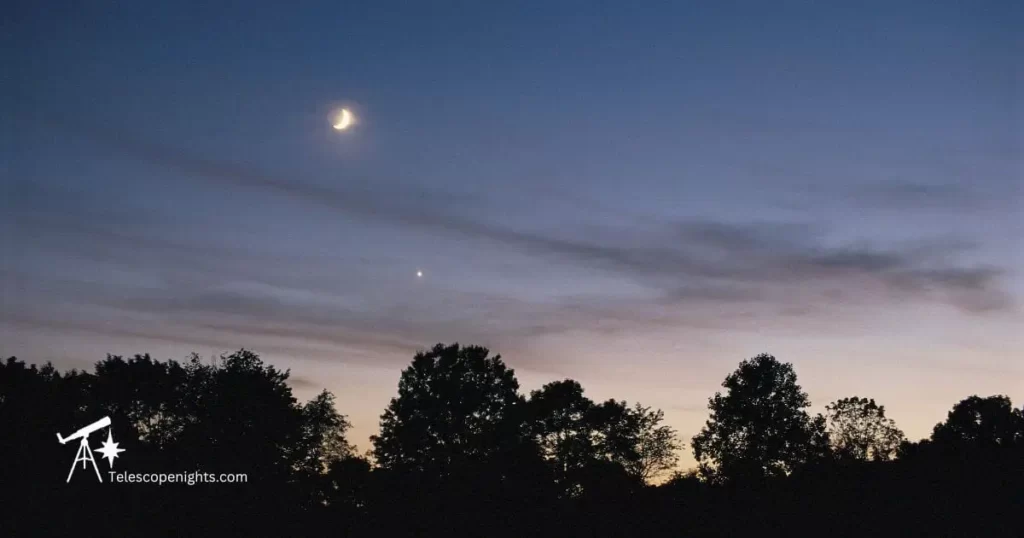It’s not that hard to spot Venus in our night sky. You might wonder what you would see looking at Venus through a telescope.

What Does Venus Look Like Through A Telescope?
Venus can look anywhere from a white tiny ball to a larger thin crescent through a backyard telescope. Because Venus is covered in thick clouds, no obvious features are apparent.
Expect to see a tiny disc when you see Venus through a telescope when it is on the opposite side of the Sun to Earth (superior conjunction).
As it moves closer to Earth in its orbit, Venus becomes larger and crescent-shaped when you look at it through your telescope until it becomes a large white circle when between the Sun and us (inferior conjunction). The image below shows this.
Does Venus have phases like our Moon? Yes, Venus is like our Moon with its phases.
How does Venus look like a crescent? Venus’s position in the orbit around the Sun, interior to Earth’s orbit, creates the shapes we see of Venus through a telescope and this includes its crescent phases.
What is Venus and where can it be found in the sky?
Venus is called the “morning star” or “evening star” but is really a planet. On the star brightness scale, it rates second to the Moon.
It’s typically visible in either the western or the eastern sky, depending on the time of year. It sits above the horizon for an hour or so around sunrise (eastern sky) or sunset (western sky). It’s one of those planets you get to see during the day, but late or early.
It’s the second planet from the Sun after Mercury. Interestingly, it is hotter than Mercury because of its thick atmosphere of mostly carbon dioxide as I wrote in Interesting Facts About Venus.
You can also find info like this at the NASA site.
What Venus looks like through a telescope in the different phases
With viewing Venus through a telescope expect to see it differently depending on where it is in its orbit around the Sun. The following image shows the phases observed of Venus over roughly three months as it orbited the Sun.

How To See Venus through a Telescope
Use a planetarium app or website to find out when Venus will rise and set in your area. I wrote tips to help you with using planetariums.
- It can be best to look above the western horizon after sunset. On a clear evening for five to six months of the year, Venus can’t be missed
- Use your telescope’s finderscope to align it with Venus
- Start with a low-power eyepiece in your best telescope to see planets and use a moon filter, as Venus is bright
- Once you find it in your telescope lens, adjust the focus and magnification until it looks clear and sharp as possible
If you are in the city, you may have issues with surrounding buildings because Venus is low in the sky (above the horizon). If you’re in a low spot surrounded by trees, you’ll also have trouble. In which case, look for an elevated spot above the tree line.
Venus orbits closer to Earth than any other planet but, because of its thick atmosphere which acts as a filter, you won’t see much when viewing Venus through binoculars or a telescope.
Venus’ cloud blanket is what you’ll see of Venus through a telescope.
But it is interesting to see Venus’ different phases.
What magnification do you need to see Venus?
You don’t need huge magnification to see Venus through a telescope. For planetary inspection, a telescope magnifying 150x is considered typically good all round.
When observing Venus through a telescope, it is recommended to use a moon filter to reduce glare and make it easier to see surface features.
Also, a Barlow lens can be used to increase magnification and see more detail. Be careful not to use too much magnification, as this can make the image blurry.
What’s On Venus
Unlike how you can see the bands of Jupiter and the rings of Saturn, what Venus looks like through a telescope is featureless. Venus has no moons or rings.
The Venus view from telescope
What you see of Venus is its thick atmosphere, which is mostly made up of carbon dioxide, with clouds of sulfuric acid that create a dense layer of haze. The atmosphere is so dense that it exerts a pressure on the surface that is 90 times greater than the atmospheric pressure on Earth.
Features You Won’t see Looking at Venus through a telescope
Venus has a rugged terrain with high mountains and deep valleys, similar to Earth’s surface. The surface is mostly covered by volcanic plains that are thought to be relatively young. The planet also has a few impact craters, but they are much less common than on other planets like the Moon or Mars.
Nasa presents a good picture of what Venus looks like under that cloud blanket. It’s an extremely hot environment and looks like a wasteland compared to our Earth.

FAQs
Why Is It Hard To See Much Of Venus Through A Telescope?
The reason you can’t see the surface features of Venus is that it is blanketed in a thick atmosphere.
Can You See Venus From Earth?
Yes. Venus is visible from Earth. It is the brightest object in the night sky after the Moon and is visible to the naked eye, appearing as a bright star.
Can Venus Be Seen At Night With A Telescope?
Venus can be seen with a telescope above the horizon for about an hour or so after dusk and an hour before dawn.
Information sources
NASA resource package: Venus |
